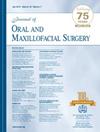Is Postoperative Steroid Use Associated With Improved Outcomes in Severe Odontogenic Infections?
IF 2.3
3区 医学
Q2 DENTISTRY, ORAL SURGERY & MEDICINE
引用次数: 0
Abstract
Background
The use of steroids as an adjunctive therapy in odontogenic infections is common, but few studies have focused on the effect of steroids in improving outcomes in these infections.
Purpose
The purpose of the study was to measure the association between postoperative steroid use and length of stay (LOS) and reoperation among patients with severe odontogenic infections.
Study design, setting, sample
The authors conducted a prospective cohort study consisting of all adult patients treated in the operating room for an odontogenic infection from August 1, 2019, to December 31, 2022, at University Medical Center of New Orleans. Patients were excluded if an odontogenic source could not be confirmed.
Predictor variable
The predictor variable was the use of steroids postoperatively (after conclusion of surgery until discharge), coded as a yes or no.
Main outcome variable
The outcome variables were total LOS, postsurgical LOS, and reoperation.
Covariates
The covariates were demographics, medical history, exam findings, diagnosis, and treatment-related variables.
Analyses
Descriptive and bivariate analyses were performed, as well as linear regression analyses. A P value of ≤ .05 was considered significant.
Results
The study sample consisted of 240 patients with a mean age of 40.3 ± 14.5 years and a sex distribution of 57.5% (138) male and 42.5% (102) female. Steroids were used in 114 patients (47.5%) postoperatively. The mean total LOS and postsurgical LOS were 3.7 ± 2.4 days and 3.1 ± 2.4 days, respectively. Reoperation was performed for 12 (5.0%) patients. Postoperative steroid use group was not significantly associated with total LOS (3.7 ± 2.6 days vs 3.6 ± 2.2 days, P = .59), postsurgical LOS (3.3 ± 2.6 days vs 2.9 ± 2.1 days, P = .13), or reoperation (58.3 vs 41.7%, P = .56) for the group that received steroids versus those that did not, respectively.
Conclusions and relevance
Postoperative steroid use was not associated with reduced LOS, postsurgical LOS, or reoperation in patients with severe odontogenic infections.
术后使用类固醇与严重牙源性感染的预后改善有关吗?
背景:使用类固醇作为牙源性感染的辅助治疗是很常见的,但很少有研究关注类固醇在改善这些感染结局方面的作用。目的:本研究的目的是测量严重牙源性感染患者术后类固醇使用与住院时间(LOS)和再手术之间的关系。研究设计、环境、样本:作者在新奥尔良大学医学中心进行了一项前瞻性队列研究,包括2019年8月1日至2022年12月31日在手术室接受牙源性感染治疗的所有成年患者。如果无法确认牙源性来源,则排除患者。预测变量:预测变量为术后(手术结束后至出院)类固醇使用情况,编码为是或否。主要结局变量:结局变量为总LOS、术后LOS和再手术。协变量:协变量为人口统计学、病史、检查结果、诊断和治疗相关变量。分析:进行描述性和双变量分析,以及线性回归分析。P值≤0.05被认为是显著的。结果:研究样本包括240例患者,平均年龄40.3±14.5岁,性别分布为男性138例(57.5%),女性102例(42.5%)。114例(47.5%)患者术后使用类固醇。平均总LOS为3.7±2.4天,术后LOS为3.1±2.4天。再次手术12例(5.0%)。术后类固醇使用组与总LOS(3.7±2.6天vs 3.6±2.2天,P = 0.59)、术后LOS(3.3±2.6天vs 2.9±2.1天,P = 0.13)、再手术(58.3% vs 41.7%, P = 0.56)均无显著相关。结论和相关性:严重牙源性感染患者术后使用类固醇与降低LOS、术后LOS或再手术无关。
本文章由计算机程序翻译,如有差异,请以英文原文为准。
求助全文
约1分钟内获得全文
求助全文
来源期刊

Journal of Oral and Maxillofacial Surgery
医学-牙科与口腔外科
CiteScore
4.00
自引率
5.30%
发文量
0
审稿时长
41 days
期刊介绍:
This monthly journal offers comprehensive coverage of new techniques, important developments and innovative ideas in oral and maxillofacial surgery. Practice-applicable articles help develop the methods used to handle dentoalveolar surgery, facial injuries and deformities, TMJ disorders, oral cancer, jaw reconstruction, anesthesia and analgesia. The journal also includes specifics on new instruments and diagnostic equipment and modern therapeutic drugs and devices. Journal of Oral and Maxillofacial Surgery is recommended for first or priority subscription by the Dental Section of the Medical Library Association.
 求助内容:
求助内容: 应助结果提醒方式:
应助结果提醒方式:


